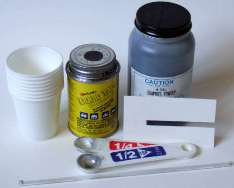Categories: Featured Articles » Sharing experience
Number of views: 84993
Comments on the article: 1
How to make a conductive paste yourself
 We note immediately that "conductive pastes" in the literature are much more often called "conductive adhesives." This name is more accurate - because, in fact, the main thing in the installation is to fasten, glue the parts. And whether such glue will have the consistency of a paste or, say, liquid sour cream - this is a secondary matter.
We note immediately that "conductive pastes" in the literature are much more often called "conductive adhesives." This name is more accurate - because, in fact, the main thing in the installation is to fasten, glue the parts. And whether such glue will have the consistency of a paste or, say, liquid sour cream - this is a secondary matter.
And one more reservation: it is not necessary to think that electrically conductive glue should be used for installation of any details through which current should pass. Old, tested soldering and easier, and more affordable, and cheaper. And that, perhaps the most important thing, solders are produced by industry, and electrically conductive glue has to be done in a handicraft way.
In any case, conductive glue should be used only when the material either cannot be brazed, or pickling before brazing is undesirable, or parts cannot be heated (which is inevitable during soldering).
Synthetic resins per se (namely, they are based on which electrically conductive adhesives are made) do not conduct current. And therefore, fillers are introduced into them - highly dispersed metal powders, for example, gold, silver, copper, nickel. The most commonly used silver. In order for the glue to conduct current, a lot of metal powder has to be introduced - about 70-75% of the total weight of the glue. Naturally, such a thickened adhesive has a paste consistency.
The specific volume resistance of adhesives largely depends on the quality of the powder, the grain size of the metal.
The main requirements for a metal filler of conductive paste are reduced to ensure that it does not interact with atmospheric oxygen and a binder - the basis of glue. Therefore, powders of precious metals, and first of all the cheaper of them - silver, have gained distribution. Nickel, intended for glue, can only be stored in an atmosphere of dry air: in the presence of moisture, it becomes coated with a thick oxide film and loses its conductive properties, and in dry air this film is thinner and breaks through current.
There are many ways to obtain silver powder. Here is another simple enough method - recovery from a solution of formalin in an alkaline environment. A solution of silver nitrate is mixed with an equal amount of a 1% formalin solution and heated to 70–80 ° C. Then add a few drops of a 5% solution of ammonia (ammonia). In this case, a black precipitate of silver precipitates, which must be filtered off, washed on the filter with distilled water, and then dried at a temperature of 105-150 ° С.
Now - a little about the binder. In most cases, these are epoxies.
Of domestic epoxies, ED-5 resin is suitable for glue. Plasticizers reduce the electrical conductivity of the adhesive, but they are still often injected, as they dilute the resin and allow the addition of an additional amount of metal powder.
Here is one of the possible recipes for glue (in parts by weight): liquid epoxy resin - 100, silver powder - 250-300, dibutyl phthalate (plasticizer) - 10-15, polyethylene polyamine (hardener) - 8-12. You need to try so that the glue does not get on your hands or skin, if this does happen, you must immediately wash off the glue with warm water and soap.
The hardener is introduced immediately before use, and after that the glue must be used within an hour, otherwise it will harden. The remaining components can be stored in mixed form for a very long time. True, heavy metal powder can settle to the bottom. To delay this process, sometimes a little bit of colloidal graphite is added to the mixture.
After applying the adhesive, it is advisable to heat the adhesive joint to 70-100 ° C and maintain it for 1-5 hours at this temperature! In this case, the electrical conductivity of the adhesive will increase. And that's why.When curing the adhesive film due to shrinkage, internal stresses arise in it. Contact forces appear between neighboring metal particles, the particles are pressed against each other and form, as it were, chains through which, in fact, an electric current passes.
When heated, the adhesive cures more fully, it becomes stronger, but at the same time, shrinkage increases and, as a result of this, the conductive properties are improved.
Pavel Baranov
See also at bgv.electricianexp.com
:
